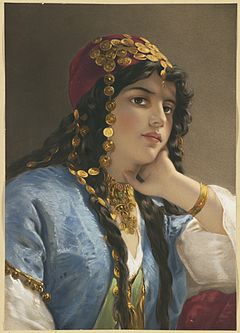Cariye
Cariye (Arabic: جارية, "Jariya") was a title and term used for category of enslaved women concubines in the Islamic world of the Middle East.
[citation needed] In Islamic law, the enslavement of a woman was the only case in which concubinage was legally permitted.
After the Ottoman Empire had conquered most of the Middle East, and after the borders to Christian Europe had come to a standstill, there was in practice few opportunities to capture women through warfare.
[2] The cariye was always regarded as sexually available for the master of the house, and if she bore a child by him, she could no longer be sold.
[4] In the first half of the 19th century, slavery had come to be regarded as morally wrong in the Western world.
The liberal Sultan Abdulmejid I, who was affected by these views, included anti-slavery laws among his Westernized reforms, and formally banned the cariye slavery system.
[citation needed] This was, however, a formal ban, and in reality, the cariye continued informally until the end of the 19th century.
A cariye who proved to be a valuable servant could be promoted to kalfa or usta, which meant she earned wages.
If a cariye was neither promoted to kalfa nor chosen as a sexual partner by the sultan, she was manumitted after nine years of service.


